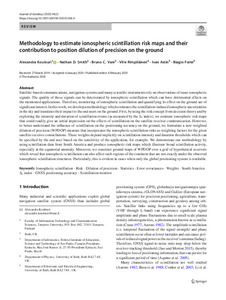Methodology to estimate ionospheric scintillation risk maps and their contribution to position dilution of precision on the ground
Koulouri, Alexandra; Smith, Nathan D.; Vani, Bruno C.; Rimpiläinen, Ville; Astin, Ivan; Forte, Biagio (2020)
Koulouri, Alexandra
Smith, Nathan D.
Vani, Bruno C.
Rimpiläinen, Ville
Astin, Ivan
Forte, Biagio
2020
22
Julkaisun pysyvä osoite on
https://urn.fi/URN:NBN:fi:tuni-202008276711
https://urn.fi/URN:NBN:fi:tuni-202008276711
Kuvaus
Peer reviewed
Tiivistelmä
Satellite-based communications, navigation systems and many scientific instruments rely on observations of trans-ionospheric signals. The quality of these signals can be deteriorated by ionospheric scintillation which can have detrimental effects on the mentioned applications. Therefore, monitoring of ionospheric scintillation and quantifying its effect on the ground are of significant interest. In this work, we develop a methodology which estimates the scintillation induced ionospheric uncertainties in the sky and translates their impact to the end-users on the ground. First, by using the risk concept from decision theory and by exploiting the intensity and duration of scintillation events (as measured by the S4 index), we estimate ionospheric risk maps that could readily give an initial impression on the effects of scintillation on the satellite-receiver communication. However, to better understand the influence of scintillation on the positioning accuracy on the ground, we formulate a new weighted dilution of precision (WPDOP) measure that incorporates the ionospheric scintillation risks as weighting factors for the given satellite-receiver constellations. These weights depend implicitly on scintillation intensity and duration thresholds which can be specified by the end-user based on the sensitivity of the application, for example. We demonstrate our methodology by using scintillation data from South America, and produce ionospheric risk maps which illustrate broad scintillation activity, especially at the equatorial anomaly. Moreover, we construct ground maps of WPDOP over a grid of hypothetical receivers which reveal that ionospheric scintillation can also affect such regions of the continent that are not exactly under the observed ionospheric scintillation structures. Particularly, this is evident in cases when only Global Positioning System (GPS) is available.
Kokoelmat
- TUNICRIS-julkaisut [16858]
